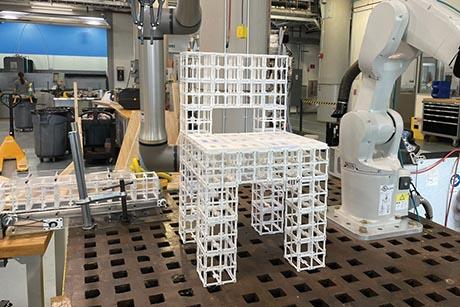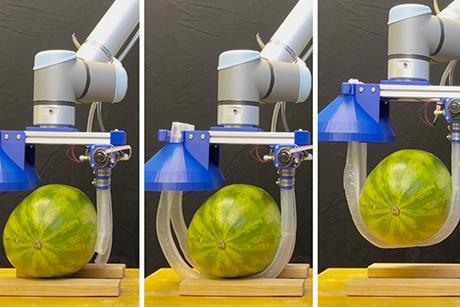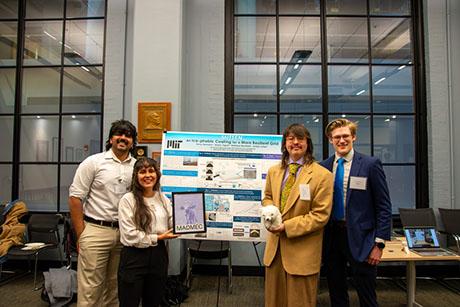Faculty Research: Professor Harry Asada
Engineering Light-Activated Muscles
by Jennifer Chu, MIT News Office
Many robotic designs take nature as their muse: sticking to walls like geckos, swimming through water like tuna, sprinting across terrain like cheetahs.

Photo credit: MIT News Office
Now, scientists at MIT and the University of Pennsylvania are taking more than inspiration from nature – they’re taking ingredients. The group has genetically engineered muscle cells to flex in response to light, and is using the light-sensitive tissue to build highly articulated robots. This “bio-integrated” approach, as they call it, may one day enable robotic animals to move with the strength and flexibility of their living counterparts.
Harry Asada, the Ford Professor of Engineering in MIT’s Department of Mechanical Engineering, says the group’s design effectively blurs the boundary between nature and machines.
“With bio-inspired designs, biology is a metaphor, and robotics is the tool to make it happen,” says Asada, who is a co-author on the paper. “With bio-integrated designs, biology provides the materials, not just the metaphor. This is a new direction we’re pushing in biorobotics.”
Seeing the light
Asada and MIT postdoc Mahmut Selman Sakar collaborated with Professor Roger Kamm to develop the new approach. In deciding which bodily tissue to use in their robotic design, the researchers set upon skeletal muscle – a stronger, more powerful tissue than cardiac or smooth muscle. But unlike cardiac tissue, which beats involuntarily, skeletal muscles – those involved in running, walking, and other physical motions – need external stimuli to flex.
Normally, neurons act to excite muscles, sending electrical impulses that cause a muscle to contract. In the lab, researchers have employed electrodes to stimulate muscle fibers with small amounts of current. But Asada says such a technique, while effective, is unwieldy. Moreover, he says, electrodes, along with their power supply, would likely bog down a small robot.
Instead, Asada and his colleagues looked to a relatively new field called optogenetics, invented in 2005 by MIT’s Ed Boyden and Karl Deisseroth from Stanford University, who genetically modified neurons to respond to short laser pulses. Since then, researchers have used the technique to stimulate cardiac cells to twitch.
Asada’s team looked for ways to do the same with skeletal muscle cells. The researchers cultured such cells, or myoblasts, genetically modifying them to express a light-activated protein. The group fused myoblasts into long muscle fibers, then shone 20-millisecond pulses of blue light into the dish. They found that the genetically altered fibers responded in spatially specific ways: Small beams of light shone on just one fiber caused only that fiber to contract, while larger beams covering multiple fibers stimulated all those fibers to contract.
A light workout
The group is the first to successfully stimulate skeletal muscle using light, providing a new “wireless” way to control muscles. Going a step further, Asada grew muscle fibers with a mixture of hydrogel to form a 3D muscle tissue, and again stimulated the tissue with light – finding that the 3D muscle responded in much the same way as individual muscle fibers, bending and twisting in areas exposed to beams of light.
The researchers tested the strength of the engineered tissue using a small micromechanical chip – designed by Christopher Chen at UPenn – that contains multiple wells, each housing two flexible posts. The group attached muscle strips to each post, then stimulated the tissue with light. As the muscle contracts, it pulls the posts inward; because the stiffness of each post is known, the group can calculate the muscle’s force using each post’s bending angle.
The light-sensitive muscle tissue exhibits a wide range of motions, which may enable highly articulated, flexible robots. One potential robotic device may involve endoscopy, a procedure in which a camera is threaded through the body to illuminate tissue or organs. Asada says a robot made of light-sensitive muscle may be small and nimble enough to navigate tight spaces – even within the body’s vasculature.
“We can put 10 degrees of freedom in a limited space, less than one millimeter,” Asada says. “There’s no actuator that can do that kind of job right now.”
Another possible use may be in drug screening for motor-related diseases. Scientists may grow light-sensitive muscle strips in multiple wells, and monitor their reaction – and the force of their contractions – in response to various drugs.
Read the published paper here: http://rsc.li/UbM1Ak
Read the full MIT News article: http://bit.ly/S0pT1y


